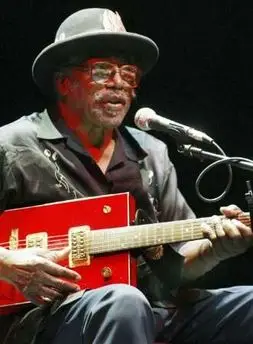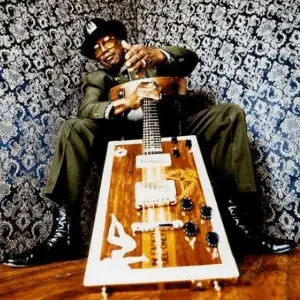BO DIDDLEY
 In 1945, Ellas McDaniel was a 16 year-old punk hanging out on the corner of 47th and Langley Avenue in Chicago’s ‘black belt’, playing the Blues with John Lee Hooker‘s young cousin Earl Hooker, who was his class-mate. Working in a grocery store, a meat packing plant, spreading ‘blacktop’ and “anything to make a buck”, he soon formed The Hipsters with Jody Williams and Roosevelt Jackson to try and get some paying gigs. By ’48, they had a residency at the 708 Club, and with the addition of drummer Clifton Jones and maracca fiend Jerome Green, the heavy shuffling pulse of Bo Diddley’s Music was starting to take shape. It would go on to change the sound of the Blues.
In 1945, Ellas McDaniel was a 16 year-old punk hanging out on the corner of 47th and Langley Avenue in Chicago’s ‘black belt’, playing the Blues with John Lee Hooker‘s young cousin Earl Hooker, who was his class-mate. Working in a grocery store, a meat packing plant, spreading ‘blacktop’ and “anything to make a buck”, he soon formed The Hipsters with Jody Williams and Roosevelt Jackson to try and get some paying gigs. By ’48, they had a residency at the 708 Club, and with the addition of drummer Clifton Jones and maracca fiend Jerome Green, the heavy shuffling pulse of Bo Diddley’s Music was starting to take shape. It would go on to change the sound of the Blues.
Othar Ellas Bates was adopted as a baby and raised in McComb MS by his Aunt, Gussie McDaniel, and had taken her name by the time they moved to Chicago when he was aged six. Ellas had played violin in the Ebeneezer Baptist Church band and when he got a guitar for his 12th birthday he tuned it like a violin and tried strumming the strings quickly to imitate a bow lick, using single fingers on the fretboard. “See, most guitar players have got little-bitty skinny fingers. Look at these ‘meat-hooks’!…. My fingers were slow, but my hands were fast!…. I was all rhythm”. When he wanted an electric guitar, he made his own with the pick-up from a Victrola record-player cartridge and a second-hand Diamature tremolo. He also built huge speaker cabinets full of 10 inch Fender speakers, with one in the back so the drummer could hear! “I came up with that ‘freight-train drive’- that’s what I call it.”
Bo Diddley in 1955!
This double sided classic came out in March 1955 and went to No.2 in the Billboard R&B chart. In May, Muddy Waters released ‘Mannish Boy’ and many thought it was a copy of Bo’s hit, but Bo was gracious enough to say that ‘I’m a Man’ had been inspired by Muddy’s tune ‘She Moves Me’. Bo Diddley’s star was certainly on the rise when his next hit, ‘Diddley Daddy’ was picked up by Alan Freed who used it for the title of a nationwide tour for Bo with support from the likes of Little Walter, Dinah Washington and a host of top-notch acts. Then came ‘Pretty Thing’, Diddy-Wah-Diddy’ (a reworking of a Blind Blake song), ‘Cops and Robbers’ and ‘Who Do You Love?’, that masterpiece of voodoo braggadocio.
Like many black originators, Bo Diddley was passed over by the media in favour of younger (and whiter) acts. He didn’t cross over to the white audience as easily as Chuck Berry because his ghetto humour and loud raunchy style was just too black for the mainstream. He certainly thrilled his live audiences with his huge driving sound and spinning, dipping, high-kicking stage presence, and his sharp-dressed style also got him a radio commercial for Royal Crown Hair-oil! The hits kept coming, with ‘Hey Bo Diddley’, ‘Mona’, ‘Roadrunner’ and ‘Bo Diddley’s a Gunslinger’, (he always carried a pistol!) He was true to his Blues roots, releasing ‘Before You Accuse Me’ and an instrumental Blues, ‘Clock Strikes Twelve’.
Bo Diddley’s showmanship rocked the joint right to the end!
 Bo Diddley was an innovator in many ways. He brought Peggy Jones (Lady Bo) into the band in 1957, and she was near Bo’s equal in laying down heavy throbbing guitar beats. When she left in 1961, he introduced Norma-Jean Wofford (The Dutchess), and most of Bo’s bands featured female players. Bo’s customised guitars were another trademark. He commissioned Gretsch to make guitars to his specifications, but they weren’t allowed to sell copies. The red rectangular model was probably Bo’s iconic guitar, but others were round, triangular, spaceship-shaped, covered in fabric and even carpet (!!) and perhaps the most spectacular was the ‘Cadillac Tail’ based on the rear fins of a ’59 Caddy.
Bo Diddley was an innovator in many ways. He brought Peggy Jones (Lady Bo) into the band in 1957, and she was near Bo’s equal in laying down heavy throbbing guitar beats. When she left in 1961, he introduced Norma-Jean Wofford (The Dutchess), and most of Bo’s bands featured female players. Bo’s customised guitars were another trademark. He commissioned Gretsch to make guitars to his specifications, but they weren’t allowed to sell copies. The red rectangular model was probably Bo’s iconic guitar, but others were round, triangular, spaceship-shaped, covered in fabric and even carpet (!!) and perhaps the most spectacular was the ‘Cadillac Tail’ based on the rear fins of a ’59 Caddy.
Bo Diddley was a true original: hugely influential and much imitated. He kept on thrilling audiences right up until he passed away in June 2008 and I doubt we will ever see his like again.
